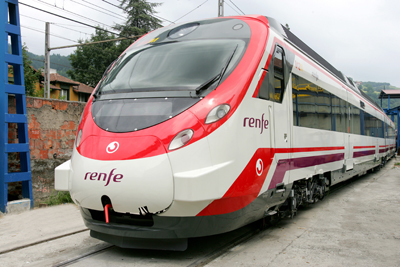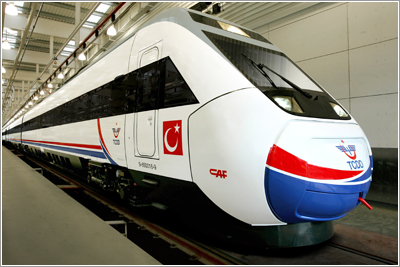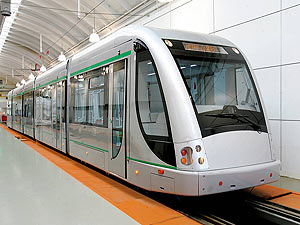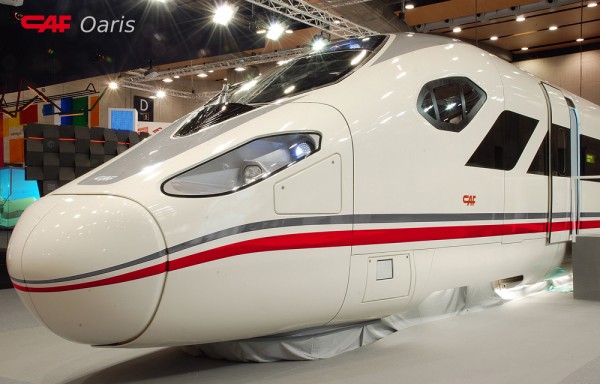Auckland’s New Spanish Trains?
A consortium of Madrid-based Construcciones y Auxiliar de Ferrocarriles S.A./ and Japan’s Mitsubishi Corporation are in the running to build Auckland’s new electric trains.
We know what the other contender on the short list - South Korea’s Hyundai Rotem Company- is about as they are building Wellington’s 48 Matangi EMU trains.
But what do we know about the Spanish company?
CAF (Construcciones Y Auxiliar De Ferrocarriles) has focused on the railway industry for the last 90 years, expanding its activities from Spain towards international markets. CAF designs, manufactures, delivers, commissions and maintains a range of vehicles for passenger railway services including tramways, light rail vehicles, metro cars, locomotives and passenger coaches.
They were on the shortlist to build the Matangi trains.
So far this year they have won contracts to build trains for Stockholm, through the company SL AB (company responsible for the transport network in the city). It’s a contract for the supply of 15 LRVs, with the possibility of exercising up to 121 LRVs.
CAF was also chosen by the Grand Beacon region (in the French department of Doubts, in the Franche-Comté Region), as supplier of rolling stock for a new LRV line. The precise number of LRVs shall be established according to the traffic, but will initially range between 15 and 18.
This follows successful tenders, especially throughout Europe - international tenders for trains in Edinburgh, Belgrade and Antalya (Turkey), as well as those in Zaragoza, Granada, Málaga, Seville, Bilbao and Vitoria.
This is what they say on their website about their EMU commuter train and their specs for the tech-minded.
 The CIVIA train is a high-speed electric unit which runs on urban and suburban commuter lines, with a large passenger transport capacity and frequent stops.
The CIVIA train is a high-speed electric unit which runs on urban and suburban commuter lines, with a large passenger transport capacity and frequent stops.
For these purposes it has been equipped with a high specific power to permit accelerations of over 1 m/sec2, suitable devices for passenger access, transit and evacuation, and an integrated COSMOS command and control system (TCN standard).
Passenger comfort improvements include, among others, video-information and special facilities for the disabled (adapted doors and access ramps, low-floor coach, etc).
Exterior: aerodynamic headstock, streamlined roof, underframe fenders, and each side of the train has a continuous glazed appearance.
Interior: the train is continuous, the coaches being linked by a diaphanous inter-circulation corridor.
The CIVIA is designed as a modular train consisting of six basic elements:
end coaches with driver’s cab (A1 and A2), a low-floor intermediate coach (A3), a normal-floor intermediate coach (A4), a conventional end trailer bogie (ETB), and an intermediate shared motor bogie (SMB). These elements can be used to form up to four types of units: 2, 3, 4 and 5 coaches.
Bogies
The free end of the front and rear coaches is supported by an end trailer bogie (ETB) and the other end is supported by a shared motor bogie (SMB), shared with the adjacent coach. Both ends of the intermediate coaches are supported by on shared bogies. All the bogies have two axles, with running surface-hardened solid wheels.he The primary suspension is based on rubber springs and the secondary suspension is pneumatic.
The motor bogies are fitted with two asynchronous traction motors, suspended from the underframe, which operate each axle by means of a coupling and a single-stage reducer scotched onto the axle.
Performance:
- Acceleration from 0-100 Km/h (m/s2): 0,7
- Average deceleration at 120 Km/h (m/s2): 1,1
- Emergency deceleration (m/s2): 1,3
- Maximum speed (Km/h): 120
- Power for auxiliaries (KW): 320
- Seating places per train unit: 126/169/223/277
- Service acceleration (m/s²): 1
- Service deceleration (m/s2): 1,1
- Specific area for bicycle storage: -
- Standing places per train (6p/m2): 288/438/579/720
- Start up acceleration (m/s2): 1,1
- Total traction power (kW): 2200
Equipment:
- Air conditioning
- Announcements to passengers
- ASFA System
- Automatic couplers
- Automatic station announcer and graphics of active lines
- Batteries: 2 x 140 A.h
- Cab air conditioning
- Color video equipment
- Dead-man
- Diaphanous gangway
- Electric door mechanism
- Electric operation
- Fire recording central unit
- Front and side (one on each side) destination signs on the exterior
- IGBTS power electric equipment
- Lighting
- Mobile radiotelephony equipment for train-land communication
- Passenger information
- Passenger saloon air conditioning
- PMR Ramps (disabled persons)
- Public Address System and background music with compact disc player
- Saloon air conditioning
- Sander
- Space for bicycles
- Space for wheelchairs
- Station warning announcement
- Wheel spin protection and wheel slide protection
Cosmos System
STANDARD IEC 61375-1, also known as TCN (Train Communication Network), is a regulation developed by the IEC (International Electrotechnical Commitee) in cooperation with the UIC.
Since its very origin, CAF has been an active member of the international group for the development of the TCN, and it is the first and only Spanish company to develop such a system.
af has incorporated this system to the new series of RENFE (CIVIA) commuter trains.
What does the TCN do?
The TCN standard’s goal is to develop a communication network, customized to the railway environment, guaranteeing interoperatibility at two levels:
- On the one hand, at the train-borne equipment level. The TCN thoroughly specifies a communication protocol for the vehicle’s bus. This protocol allows the easy and uniform access to all the information on the train and turns the integration of new equipment and control system functionalities into practically plug-and-play.All electronic equipment installed in the train operates under a single standard network, simplifying information transmission. In other words, all the equipment “speaks” the same language.This unique network allows the information exchange and the train’s functioning to be flexible and open to the incorporation of new functionalities and technologies such as GSP, GSM and the Internet.In addition to this, the use of the TCN significantly simplifies qualified personnel training and train fine-tuning and maintenance.
- Also, at the train level, the TCN communication standard allows the vehicle’s bus to automatically couple two or more units. Without any external assistance, the system reconfigures itself, incorporating the vehicle’s equipment or unit connected to the network.
See also:
Trains will be here in 2013
The short list















19 Comments
The Sevilla trains looks great! that’ll do. Y dos Cerveca per favor….
Yes please!
The Matangi ones look ugly when compared!!
CAF has got years and years of great performance and design history. Most of the Spanish urban/suburban trains are made by them and they are magnificent. Mind you, most of them run on a much broader gauge than ours, so the design and abilities will have to be minimized. Still, we would be jumping into a great comfort and premium technology. Bring them now please
Haha, dont remind me on the Istanbul train. Took a plane from Istanbul to Ankara and then back a week later. When I got back to Istanbul, I saw the train and found out it would have taken only a little longer and costed only $25 dollars. Better than paying for the plane ticket.
BE CAREFUL re-train suppliers. Over here in Melbourne we had a batch of trains supplied from Seimens. Good trains, but they had problems stopping (especially in wet conditions) & over ran platforms. Seems there is nothing wrong with the braking mechanism, but… as these trains were made for tunnels, they couldn’t reasonably be expected to work all the time in surfare lines of varying quality or in the wet. Seems it’s a brake software feature.
Idiots who signed the contract on behalf of the Victorian Gov’t & the then Connex operators should have been able to see through that one.
Now for Auckland.., be careful with your suppliers. I’t does rain in Auckland, & not much in Spain & despite good new trackage, watch for trains already working in similar (surface) conditions.
I wonder if we are going to see the current blue, grey and yellow scheme of exisiting trains applied to the new ones Personally I’d like to see nothing but blue and white on our trains. Auck-land F**k Yeah.
nice - either of the two final options will be marvellous.
Thanks Jon for keeping us updated.
Thanks Jon for the information on CAF. Very interesting.
I concur with Carl. Much as I love the idea of riding Spainsh trains, we shouldn’t let romanticism get in the way of practicalities.
We do have rainy / showery winters, there is high humidity both summer and winter in Auckland, there is alot of ‘lumpy’ terrain in the Auckland central area.
I do fear for the negotiators on our side. Kiwi’s tend to forget practicalities like these, and given the standard of management expertise (remember Binglish has exported alot of this to Australia and beyond) it is a real fear.
Chris, don’t get all gloomy again. You may be surprised to know that the Spanish have tons of mountains, and they do know about rain and even snow there in Europe. Also, trains don’t do “lumpy” anyway, Auckland terrain or not.
There’s never absolute certainty that what you will purchase will work well, but it’s great that we apparently are getting suppliers with good track records, and tons of experience.
What European capital is at the highest altitude? Madrid. They can cope. Frankly, and I don’t really want to be negative but those Matangis look a little plodding to me, especially compared to the Seville number above. Surely KR can write a spec. that’ll work. Let’s get the sexy ones! A little romance does wonders to sell a service. Let’s not get sucked into daft talk of ‘nice to haves’ versus ‘necessities’. Nice to haves are necessities. It’s called quality.
I think the CIVIA train is unlikely for Auckland as that is the continental model - and requires a continental loading gauge. I’d expect a body shell similar to some of their British or Irish units (where the loading guage is similar to NZ). Something a bit more like this: http://www.caf.es/ingles/productos/proyecto.php?cod=3&id=496&sec=datos (but electric & with an intermediate low floor car)
Matangi looked ok until they decided against autocouplers, and for the door out the front, meaning a lot of extra crap got slung onto the end and so ruining their looks.
CaF, Rotem, and Bombardier tendered for Matangi.
@ Mark - thanks. Yes, you are right, Spain can be lumpy, and yes it does rain there… just less than here, but I understand in the North of Spain it is very similar to here - humid, green and beautiful.
Given that, I’m plumping for Spainish trains!
@Kegan If there`s one thing I definitely want different from the Nth Ireland train specs is 3 doors each side per unit rather than two.
Matangis have to have a door in the front for emegency exiting in the Johnsonville Line’s single-track tunnels.
By the way, the French CAF LRV order is with Grand Besancon (not Beacon), in the department of Doubs (not Doubts).
“By the way, the French CAF LRV order is with Grand Besancon (not Beacon), in the department of Doubs (not Doubts).”
Spellcheck gone wild.
Can the loading gauge/axle load limits in auckland handle shared bogies?
HAHAHA¡¡¡¡¡¡¡
I WORK IN CAF.IN SPAIN
you shought to think again.
I do not know how they can run trains of CAF